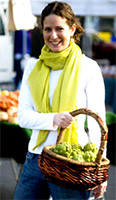Review — YOGURT CULTURE by Cheryl Sternman Rule (Eritrea)
 Yogurt Culture: A Global Look at How to Make, Bake, Sip, and Chill the World’s Creamiest, Healthiest Food
Yogurt Culture: A Global Look at How to Make, Bake, Sip, and Chill the World’s Creamiest, Healthiest Food
by Cheryl Sternman Rule (Eritrea 1995-97)
Harvest Publisher
352 pages
April 2015
$12.99 (Kindle); $19.18 (Hardback)
Reviewed by Kathleen Coskran (Ethiopia 1965-67)
•

Cheryl Sternman Rule
What a joy to read a cookbook by a talented cook who also happens to be a wonderful writer! Rule opens with a description of the creature “comforts” she and her husband created when they were Peace Corps Volunteers in Eritrea in the mid-1990s, beginning with a couch made by “folding a mattress in half and tying a few logs to it with yellow nylon rope.” She describes some of their early culinary attempts including making yogurt, but when they finally got it right, they vowed that when their Peace Corps service ended they would make yogurt forever.
It was 15 years before she fulfilled that pledge, but luckily for us, she did. Yogurt Culture is a cookbook, yes, but Rule also details both the science and health benefits in her introduction, and throughout the book, the story of yogurt in multiple cultures. The 40-page introduction may be unusually long for a cookbook, but is worth every word. She unfolds the history of yogurt — flavors, textures, colorants and preservatives; how to shop for yogurt, how to read a yogurt label, how to make yogurt yourself. There is even a page devoted to “Gender and Yogurt.” Who knew! She explains: “The genderization of food strikes me as a silly but inescapable part of product marketing, one that won’t disappear anytime soon.”
And, of course, there are the recipes, wonderful recipes, from Strawberry Rhubarb compote on page 45 to making your own Labeneh (the Mediterranean and Middle Eastern yogurt cheese) on page 329. There are the smoothies and raitas that you would expect, but bulk of the book is devoted to the full range of foods, breakfast, lunch, and dinner, main courses, snacks, appetizers, desserts, and, of course, how to make yogurt at home, including Greek yogurt, and labneh.
I’d never reviewed a cookbook before, but assumed that I should try some of the recipes before going on and on about how much I love this book. I am so glad I did. The Blood Orange, Kalamata and Red Onion Dip is an unexpected combination of blood oranges, olives, red onion, pepper and sumac in a pool of yogurt that I will be making again and again. I tried the Oven-Baked Tarragon-Scented Salmon also fabulous, and the Almond-Lemon Loaf Cake has earned a place in my list of quick, dependable, delicious desserts. Rule showed me that you can, and should, put yogurt in pretty much everything.
Another joy of the book is the gorgeous photographs by Ellen Silverman. If Rule’s evocative prose doesn’t convince you to try a recipe, Silverman’s photos certainly will. They are simple, beautifully presented, and there are a lot of them. Yogurt Culture could almost be a coffee table book, but it has too much useful information to be relegated to something occasionally paged through. Yogurt has been around since Neolithic times and is an essential part of many cultures. Rule devotes a full page each to Smári yogurt (Icelandic), Indian yogurt culture, Persian Yogurt Culture, the Mediterranean Superstar Greek yogurt, savory Afghan Yogurt, Israeli, Eritrean, Turkish, Serbian, and Mongolian yogurt cultures.
One more thing. I love her sense of humor. At the end of many recipes, there is what I am calling the “Yo!” square: an important reminder connected to the recipe. “Yo!” she says and suggests an ingredient you can substitute if you don’t have everything, offer a note on technique, lets you know it can be prepared ahead, perhaps where to find a hard-to-find ingredient, or a bit of background information she knows you would want to know.
On second thought, maybe I will keep Yogurt Culture on my coffee table, beckoning me to read it again and again, and to remember to include yogurt in every meal.
•
Kathleen Coskran (Ethiopia 1965-67) is primarily a fiction writer, but is currently working on a book about the lack of justice in the multiple criminal justice systems in the United States, based on her 25-year friendship with James Colvin, who has been incarcerated for nearly 50 years.
Kathleen, it’s a joy to read your wonderfully descriptive and bouncy writing. I’ve added Cheryl Sternman Rule’s book to my “to read” list, and I don’t even care for yoghurt!